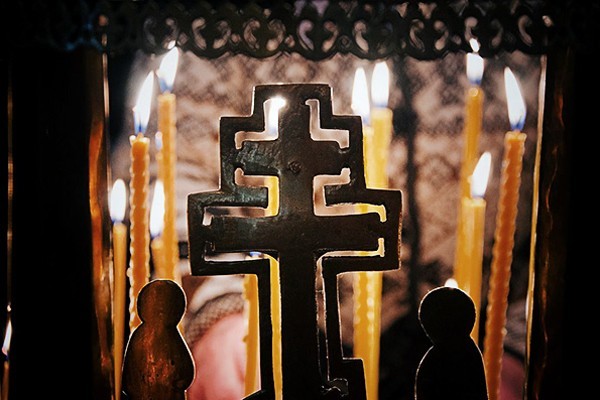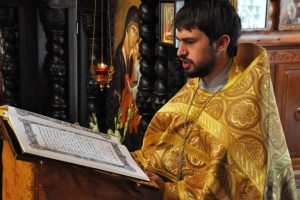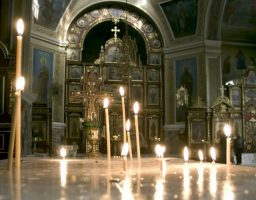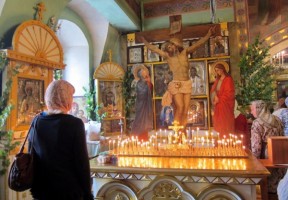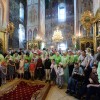May we pray for the dead? Indeed can we pray for them? The ringing “no!” thrust at me by my Protestant friends was based in large part on their conviction that there is no mention of such prayer in the Bible. In matters of faith and practice, the divine imperative is “sola scriptura.”
But what in fact does Scripture say about prayer for the departed? This is a crucial issue for Orthodox and Catholic Christians, who are often challenged by well-meaning but misguided polemics coming from Protestant friends and relatives.
There is no doubt that Jews of the intertestamental period offered prayers for those who had passed on before them. The most significant passage is probably 2 Maccabees 12. There Judas Maccabeus offers prayer for his fallen warriors who had adopted certain idolatrous practices. He and other survivors “turned to supplication, praying that the sin that had been committed might be wholly blotted out.” The narrator comments: “If he (Judas) were not expecting that those who had fallen would rise again, it would have been superfluous and foolish to pray for the dead. But if he was looking to the splendid reward that is laid up for those who fall asleep in godliness [we might add: even for those who die in sin, as did the Maccabbean warriors], it was a holy and pious thought. Therefore he made atonement for the dead, so they might be delivered from their sin” (vv. 42-45).
Here prayer for the dead and belief in the resurrection go hand in hand. It confirms the fact that in Pharisaic circles, from at least the first century before Christ, intercession for the departed was an integral part of Jewish worship.
Evidence from the catacombs shows that a similar pairing of these themes, prayer for the dead and belief in final resurrection, occurred from the very earliest period of Christian history. But is there any direct evidence in the New Testament that prayers can and should be offered for those who have died?
The only really clear allusion to such prayer is found in the Second Letter of St Paul to Timothy, 1:18. Whether or not the letter was penned by the apostle himself, or by one of his disciples, the message is clear. Paul’s friend and companion Onesiphorus is mentioned only in this letter. A disciple from Ephesus, Onesiphorus sought out Paul in Rome and extended to him a welcome hand and warm friendship. In 2 Tim 1:16, we read: “May the Lord show mercy to Onesiphorus’ household.” Then in verse 18, “May the Lord grant him (Onesiphorus) to find mercy from the Lord on that day,” meaning the day of judgment. A final reference occurs in 4:19. Here Paul sends personal greetings to Prisca, Aquila and “to Onesiphorus’s household.” The passage then ends with the naming of other of Paul’s co-workers and acquaintances.
All of this leads to the conclusion that Onesiphorus was no longer alive but rather had died before the letter was written. Yet Paul indisputably prays for him as he looks forward to the general resurrection and final judgment.
Many of those who reject prayer for the departed would argue that this is meager evidence at best. This would be especially the case with those who prefer to select a “canon within the canon,” meaning usually the “genuine” letters of Paul, restricted by the most radical to Romans, 1-2 Corinthians, Galatians, and perhaps 1 Thessalonians and Philippians. That kind of reductionism, however, wholly ignores—or rejects—the idea of biblical inspiration, particularly the patristic notion that Scripture is uniformly inspired by the Holy Spirit such that the entire canon is an authoritative and dependable witness to God’s self-revelation.
There is, in other words, a trajectory that leads from the prophecy of Daniel, through Maccabean tradition, and into 1 Corinthians and the Pastoral Epistles, which confirms that in Judaism and early Christianity prayer for the dead was an accepted and integral part of worship, as well as an appropriate preparation for the coming resurrection. It is a practice that continued without interruption through the first Christian generations, and gradually it took specific liturgical form in funeral services and memorials for the departed. Prayer for the dead is in fact presupposed as a foundation for the entire cult of saints, those who—by their own righteousness but also through intercession by the living offered for them—are recognized by the Church as having attained an exceptional degree of sanctity. There are multitudes of “saints” who have never been formally recognized as such (of course, all are “called to be saints,” 1 Cor 1:2). Some of them are friends and members of our own households. And we continue to pray for them, convinced that they intercede on our behalf before the throne of grace.
Prayer transcends both time and space. As the work of the Holy Spirit within us, prayer unites us in a transcendent, eternal communion with the Holy Trinity and with all the faithful who have preceded us through death and into life beyond. We can and we must pray for them, for their salvation and for our own. We pray for them and request their intercession for the same reason the Church has always offered that prayer: because even now we are united with them in the eternal bond we know as “the communion of saints.”












